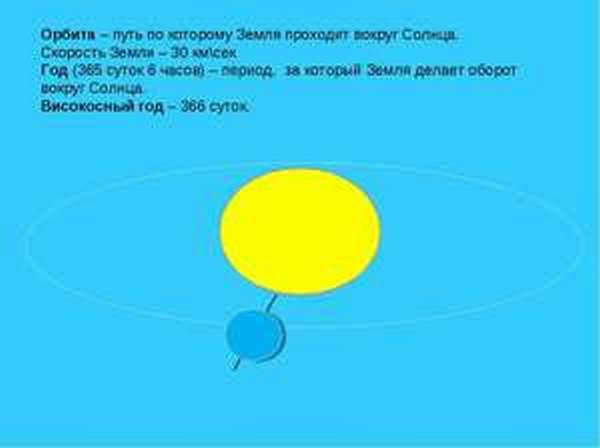
Throughout history, individuals have been curious about the transitions from night to day, winter to spring, and summer to fall. As knowledge grew, scientists directed their attention towards the Earth as part of the solar system, with a focus on determining the speed of the Earth’s rotation around the Sun and its axis.
- Movement of the Earth
- Orbital rotation
- Rate of rotation around the Sun
- Axial rotation
Movement of the Earth
All celestial objects are constantly in motion, and the Earth is no exception. It undergoes both axial rotation and orbital motion around the Sun.
To better understand the Earth’s movement, you can observe a spinner that simultaneously spins on its axis and moves swiftly across the floor. This motion is crucial for the Earth’s habitability. Without it, our planet would experience extreme conditions. One side would constantly face the Sun, resulting in scorching temperatures exceeding +100 degrees Celsius, causing all water in that area to evaporate. On the other side, temperatures would plummet, and the entire surface would be covered in ice.
Here’s an interesting fact: which planet is the farthest from the Sun?
Rotary Path
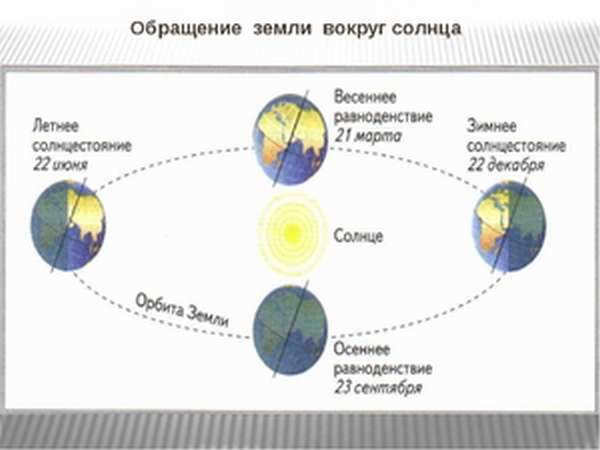
The Earth’s rotation around the sun is determined by its orbit, which is defined by the gravitational attraction of the sun and the planet’s velocity. If the gravitational force was stronger or the planet’s velocity was lower, the Earth would be pulled towards the sun. Alternatively, if gravity were to disappear or significantly weaken, the planet would be propelled tangentially into space by its centrifugal force. This can be visualized by imagining spinning an object tied to a rope above your head and suddenly letting go.
The Earth’s path around the Sun is not a perfect circle but rather an ellipse, causing the distance between the two to vary throughout the year. In the month of January, the Earth reaches its closest point to the Sun, known as perihelion, at a distance of 147 million kilometers. Conversely, in July, the Earth is farthest from the Sun, reaching a point called aphelion at a distance of 152 million kilometers. On average, the distance between the Earth and the Sun is approximately 150 million kilometers.
As the Earth orbits the Sun, it moves in a west to east direction, which is considered “counterclockwise”.
Here’s an interesting fact: let’s take a look at the distance between the Earth and the Moon.
Rate of revolution around the Sun
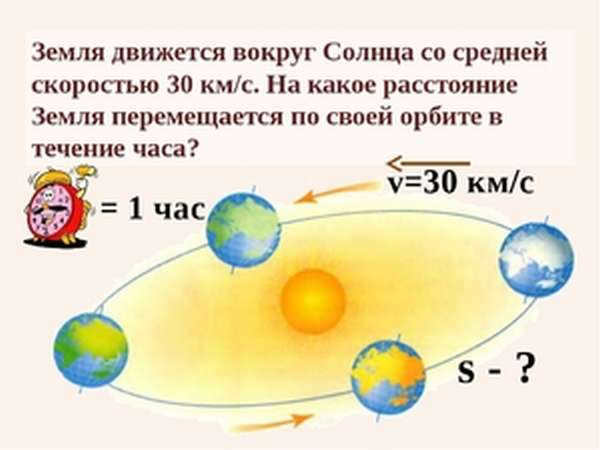
It takes the Earth 365 days, 5 hours, 48 minutes, and 46 seconds (1 astronomical year) to complete one revolution around the center of the solar system. However, for convenience, a calendar year is considered to be 365 days, and the extra time is “accumulated” and added as one day to each leap year.
The Earth’s orbital distance is 942 million kilometers. Based on calculations, the Earth’s speed is 30 kilometers per second or 107,000 kilometers per hour. Although this speed may go unnoticed by humans, as all people and objects move in the same way within the coordinate system, it is actually quite significant. For comparison, the highest speed of a racing car is 300 kilometers per hour, which is 365 times slower than the speed at which the Earth travels in its orbit.
Nevertheless, the 30 km/s value is not consistent as a result of the orbital path being an ellipse. Our planet’s velocity fluctuates slightly throughout its journey. The most significant variation occurs when crossing the perihelion and aphelion points and amounts to 1 km/s. In other words, the average speed of 30 km/s is an approximation.
Axial rotation
The Earth’s axis is an imaginary line that can be drawn from the North Pole to the South Pole. It is inclined at an angle of 66°33′ relative to the plane of our planet. One complete rotation takes 23 hours, 56 minutes, and 4 seconds, which is known as a sidereal day.
The primary effect of axial rotation is the alternation of day and night on Earth. Additionally, this motion causes:
- The Earth to have a slightly flattened shape at the poles,
- Movements of bodies such as river currents and wind to be slightly deflected in a horizontal plane (to the left in the Southern Hemisphere and to the right in the Northern Hemisphere).
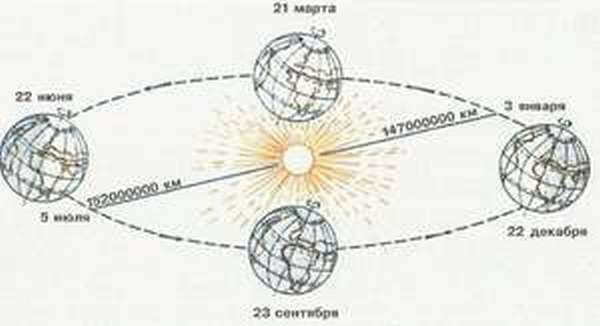
The speed of rotational movement varies significantly in different regions. The highest speed, known as linear velocity, is 465 m/s or 1674 km/h at the equator. This speed can be found, for example, in the capital of Ecuador. As you move away from the equator towards the north or south, the rotational speed decreases. For instance, in Moscow, it is almost twice as slow. These velocities are referred to as angular velocities, and they decrease as you approach the poles. At the poles themselves, the speed is zero, meaning that the poles are the only areas of the planet that have no motion relative to the axis.
It is the specific angle at which the axis is positioned that determines the variation in seasons. Different regions of the Earth receive varying amounts of heat and light at different times due to this positioning. If our planet were aligned vertically with the Sun, there would be no seasonal changes because both the northern and southern latitudes would receive equal amounts of heat and light during the day.
The rotation of the axis is influenced by the following factors:
- changes in seasons (such as precipitation and atmospheric movement),
- tides that oppose the direction of axial motion.
These factors cause the Earth’s rotation to slow down, resulting in a decrease in its speed. The rate of this decrease is very gradual, only 1 second every 40,000 years, but over the course of 1 billion years, the length of a day has increased from 17 to 24 hours.
Ongoing research is still being conducted on the motion of the Earth. This information is essential for creating precise star charts and understanding how this movement relates to natural phenomena on our planet.

Please refrain from immediately attaching labels such as a flat earth or a hollow earth. Instead, if possible, provide a point-by-point analysis. I am not the author of this material, but rather a close acquaintance. I do not possess much knowledge on this topic and would greatly appreciate any expertise. Thank you to those who respond.
1. According to scientific findings, the Earth rotates on its axis at a speed of:
40,000 km in 24 hours, which is equivalent to 1,666 km/hour
2. The Earth revolves around the Sun at a speed of: 108,000 km/hr. – 30 km/sec (150,000,000 km X 2 X 3.14 / 365 days / 24 hours). It is important to note that this occurs in a vacuum, within airless space.
When we walk on the Earth’s surface, we are unaware that the atmosphere surrounding us is moving at a speed of 1,666 km/hour along with the Earth (imagine if the atmosphere did not move at the same speed as the Earth: for comparison, the strongest hurricanes only reach speeds of 120-130 km/hour, which uproots vegetation, tears trees from their roots, and destroys buildings). This means that we are actually rotating at a speed of 1,666 km/hour.
Conclusion 1: It can be concluded that there is no force causing the Earth and the atmosphere to rotate around the Earth’s axis, as there is no mechanism to synchronize the atmosphere’s movement with the Earth’s movement at a speed of 1,666 km/hour.
Let’s imagine that the Earth and the atmosphere rotate together around the Earth’s axis. If we take a plane from Moscow to Vladivostok and back (6,400 km), we would naturally reach Vladivostok in 6.4 hours, traveling at a speed of 1,000 km/hour. On the return journey from Vladivostok to Moscow, we should be able to fly in just 2.4 hours (6,400 / 2,666). However, in reality, the round trip flight takes the same amount of time. Why is that?
Conclusion 2: Either the Earth does not rotate on its axis, or we are actually inside the Earth.
What’s even more astonishing is the Earth’s rotation around the Sun at 108,000 km/hour. If this were the case, the Earth’s atmosphere would be blown away, as neither gravity nor electromagnetism would be able to hold it in place. Let’s not forget that the Solar System also rotates at an even more impressive speed of 200 km/sec, not to mention the rotation of the Galaxy.
Conclusion 3: Assuming that the Earth indeed rotates on its axis and orbits around the Sun, it can be inferred that we are either located within the Earth or beneath a protective dome.
PS: I received negative feedback, but I am determined to provide accurate and well-supported theses and conclusions to help clarify this concept for others.

14.9K posts 45.3K followers
Community guidelines
What guidelines can be found here, other than the guidelines established by peekaboo itself 🙂
1) TC, we can only observe and perceive EVERY movement. If we are traveling somewhere at 30 km/s and the Earth is also traveling there, it appears stationary to us. There is no hurricane at 30 km/s.
2) “there is no force that would make the atmosphere rotate in synchrony with the Earth” – no force is required for that. The force was necessary to initially give those speeds. Afterward, it continues to fly and spin due to inertia without consuming any energy at all.
3) “So why is the round trip time the same in actuality?” – when we are flying FROM the planet in relation to the planet in a relatively stationary air. All three entities (Earth, us, air) are involved in the same movements (rotations around the Earth’s axis and around the Sun), so in the initial approximation, we are all essentially motionless in relation to one another (when the airplane has taxied to the takeoff line and is getting ready to accelerate). And the flight of the airplane is a result of the propulsion provided by the engines in relation to the air.
4) It doesn’t matter what it seems, what matters is what is. Moreover, we are not only rotating around the Sun at a speed of 30 km/s, but together with the Sun, we are flying at a speed of several hundred kilometers per second around the center of the Galaxy.
That’s why education is enforced for everyone.
I suggest merging this misconception into the depths of hell.
What is even more astonishing is the Earth’s rotation around the Sun at a speed of 108,000 km/hour. If it were not for gravity and electromagnetism, the Earth’s atmosphere would simply be blown away.

An extraterrestrial object that has previously entered our solar system.
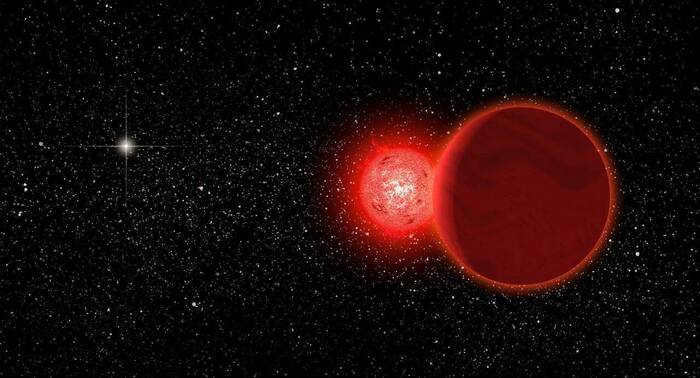

Scholz’s star is a small red dwarf that weighs 8 times less than the Sun.
What makes it intriguing is its past. It is currently located 20 light years away. However, a mere 70,000 years ago, Scholz’s star came within 0.8 light-years (or 52,000 astronomical units) of the Sun. This distance is much greater than the projected travel of Gliese 710. Scholz’s star grazed the outer edge of the Oort Cloud, potentially disrupting comets and altering their paths.
Vanished satellites of the solar system.
Humans have a tendency to misplace items on a regular basis, whether it be keys, glasses, or money. It is not typically suspected that large celestial objects exhibit similar carelessness. For thousands of years, mankind has been observing these objects without noticing anything of the sort. However, there are several indications that suggest certain planets within the solar system have, at various points in time, lost satellites in orbit around them.
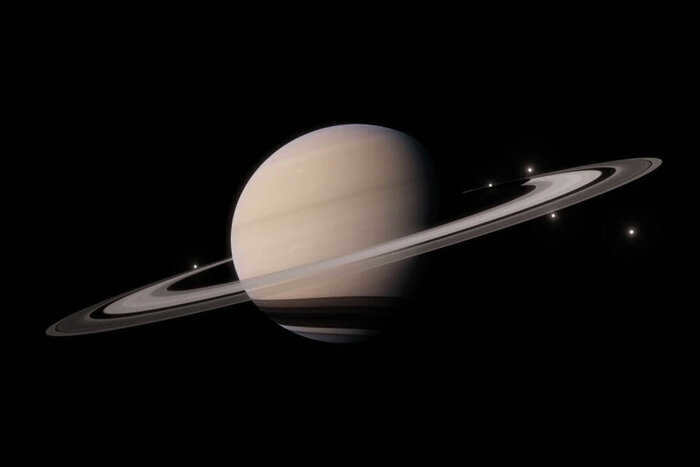
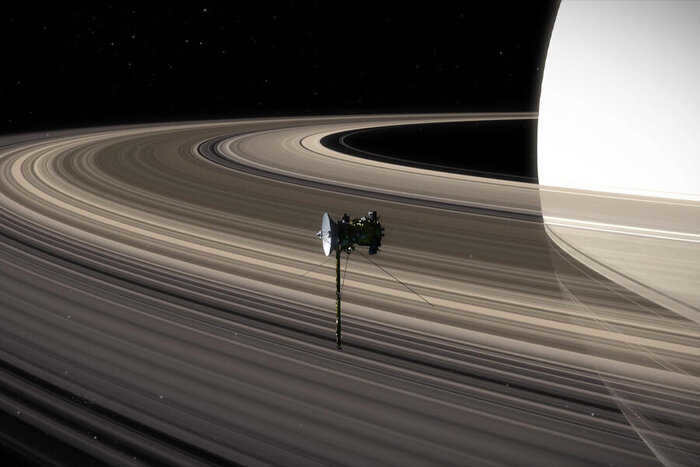
In an artist’s depiction of Saturn’s rings, the Cassini interplanetary station can be seen flying over them.
As the rings are predominantly made up of ice, they are expected to gradually fade over time and accumulate more dust. Consequently, the heavier the material on the rings, the older they are. Data from Cassini has revealed that the rings are only a few tens of millions of years old. The question remains: why did they form relatively late? A group of astronomers published a paper in 2022 proposing that the rings are remnants of a Saturnian moon that came too close to the planet and was subsequently torn apart into small fragments.

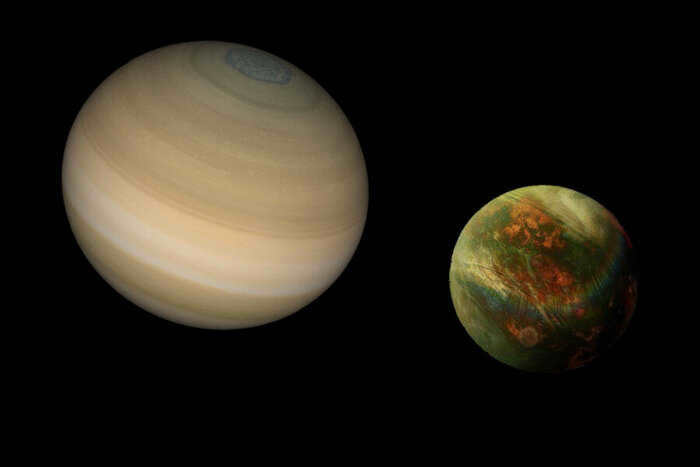
Saturn devoid of its rings and the hypothetical moon Chrysalis as depicted by the artist
Let’s venture closer to the Sun and delve into the realm of Jupiter. This colossal planet seems to have lost a significant number of its moons. Presently, there are 95, but countless eons ago, there were even more. If the one in proximity to Saturn met a grand demise, these celestial bodies were engulfed by the planet. By means of computer simulations depicting the early days of the solar system, astronomers have derived this rather disheartening deduction. The simulation incorporates an estimation of the matter required for the formation of Jupiter and its current moons, including the Galilean satellites Ganymede, Callisto, Io, and Europa, which collectively constitute over 99% of the mass orbiting this gas giant.
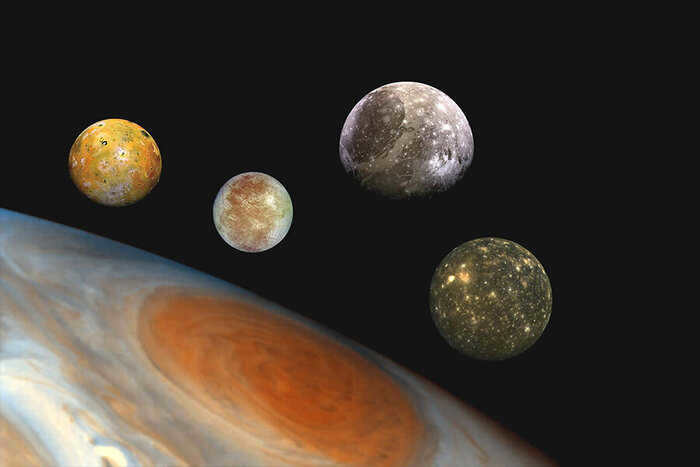
The outcome of the digital experiment yielded an unexpected result. It transpired that there was sufficient material available during that era to potentially create four additional complete sets of “Galilean moons” in close proximity to Jupiter. It is evident that computer simulations are not entirely precise, particularly considering that these events occurred billions of years ago. Nevertheless, certain experts propose that these satellites may have indeed formed during that distant time, and have even delineated the factors that contributed to their subsequent disappearance.
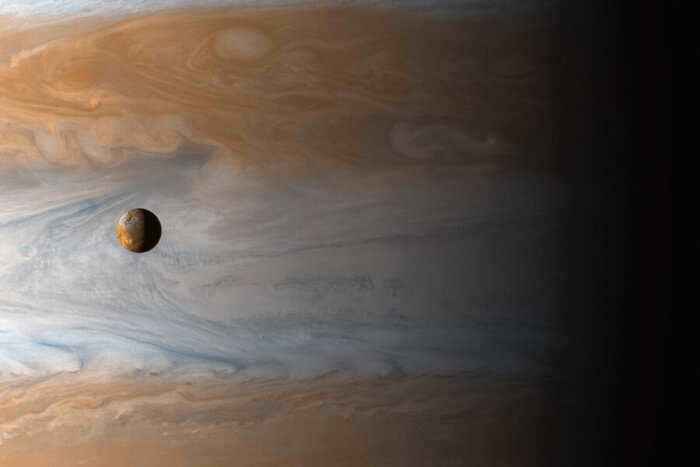
The Cassini interplanetary station reveals the wonders of Jupiter’s moon, Io
Scientists have theorized that these celestial bodies met their demise due to a phenomenon known as “overeating”. They had an abundance of building material, causing them to grow excessively large. As a result, they lost their momentum and eventually succumbed to the gravitational pull of the colossal planet. Ultimately, they would enter a death spiral and be engulfed by Jupiter. This intricate process unfolded over millions of years during the planet’s formation, leading to the demise of numerous satellites. According to this hypothesis, the Galilean moons are the last survivors of this generation, as they lacked the necessary materials to reach critical mass.
Unlike the gas giants, the Earth group of planets possesses a significantly lesser number of satellites; however, this fact does not imply that they were bestowed with greater attention. Within the orbital path of Mars, there exist two minuscule moons named Phobos and Deimos, which are named after Greek deities. The origin of these moons has been a subject of debate amongst astronomers for an extensive period. Certain individuals contend that they were created in close proximity to Mars, while others maintain the belief that they are two asteroids that strayed too far from their designated belt and were subsequently captured by the Red Planet.
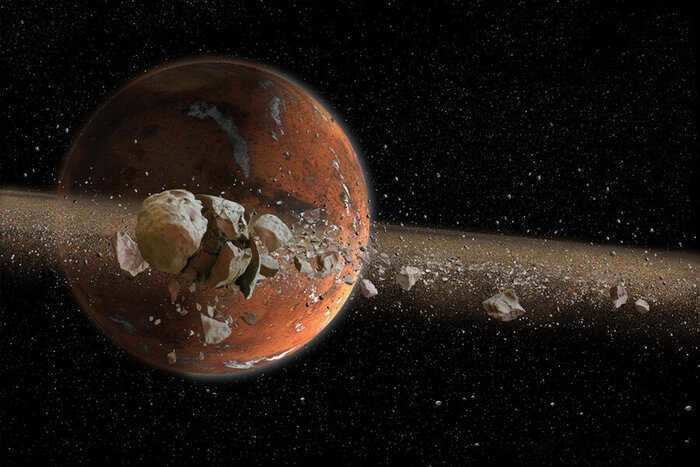
In 2021, a scientific team put forward a hypothesis suggesting that Mars had acquired a single asteroid, approximately 30 kilometers in diameter, between 1 and 2.7 billion years ago. This asteroid subsequently broke apart, giving rise to Phobos and Deimos. However, this theory was later criticized by other researchers who conducted computer simulations and identified significant flaws in the proposed scenario. According to their calculations, if Phobos and Deimos had formed through the disintegration of a larger object, they would have rapidly fragmented each other into a much larger quantity of debris.
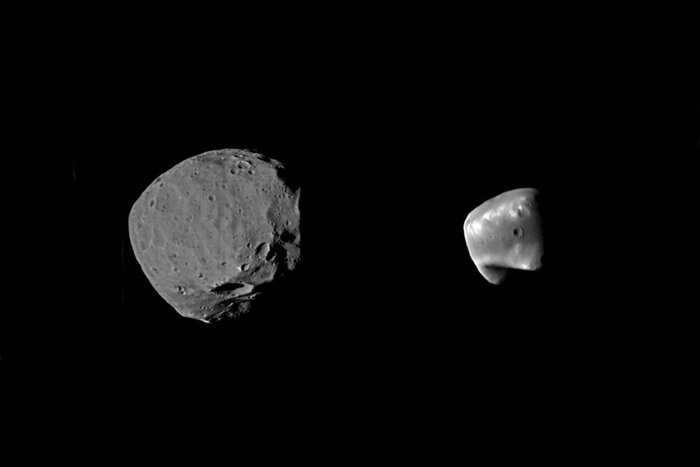

This is the conclusion of the article. The following are my thoughts on Picaboo (and beyond).
Dear friends, I recently joined Picaboo and had little knowledge about this community. I was pleasantly surprised when my posts started receiving thousands of views within the first few days. To my astonishment, one of my articles was even featured in the official Picaboo group on Vkontakte. I am also amazed by the engagement from readers like you. Your support and active comments are greatly appreciated. Thank you!
I plan to increase my activity on developing my Peekaboo page and gradually make it my main platform. The reason for this decision is that I have been working on building my channel on Zen for nearly three years. Although I have over 50,000 subscribers there, the “wonderful” recommendation system only allows my articles to receive 100-150 reads. Additionally, Zen changed their monetization system in August, resulting in a significant decrease in my channel’s daily income to 200 rubles. Given these circumstances, I believe there is no longer any reason to stay on this platform. If you have an interest in space and related topics, I invite you to join our group on Peekaboo. There are many more fascinating and informative things awaiting you here!
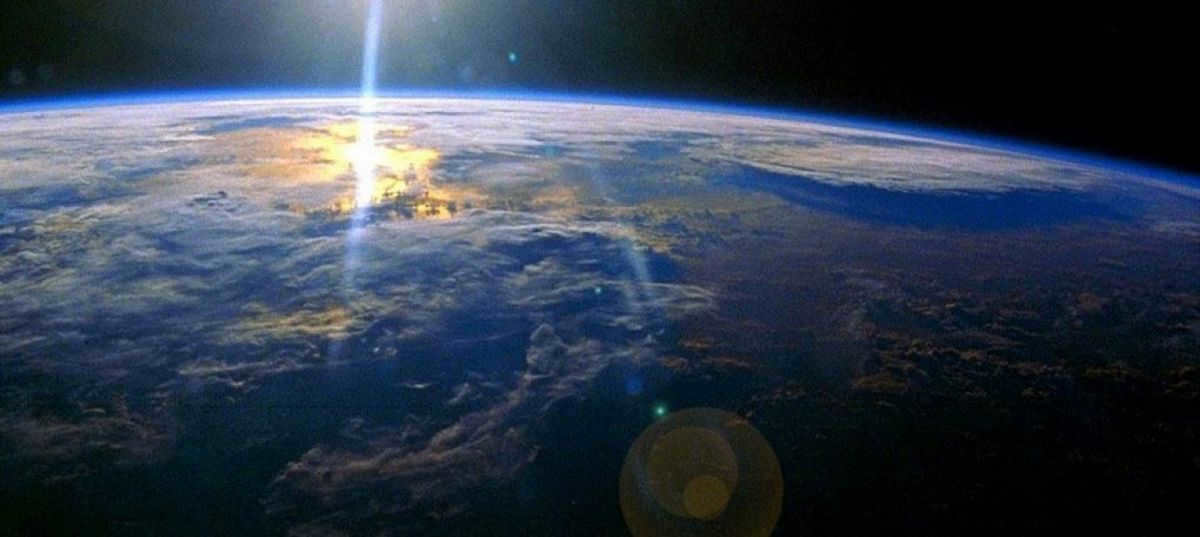
The Earth is in perpetual movement. It rotates on its axis and orbits around the Sun. But have you ever pondered the mechanics behind this phenomenon? This article aims to shed light on the Earth’s rotation and speculate on the consequences if it were to cease.
What is the tilt of the Earth’s axis?
The tilt of the Earth’s axis is the angle at which it is inclined from a vertical line. This angle is approximately 66 degrees. The Earth’s axis passes through three points: the geographic poles and the center of the planet. This tilt is responsible for the changing seasons on Earth. When the northern hemisphere is tilted closer to the sun, it experiences summer, while the southern hemisphere experiences winter. This tilt creates a difference in the amount of heat received by different parts of the Earth’s surface.
If the Earth’s axis were completely vertical, there would be no change of seasons, as all parts of the surface would receive the same amount of heat.
The Earth’s axis is unaffected by the gravitational pull of the Sun, Moon, or other celestial bodies. It maintains a steady circular rotation, following the same path and describing a cone. However, its spatial orientation can shift over time. Currently, the Earth’s northern geographic pole aligns with Polaris, but in 12,000 years it will shift in the opposite direction. At that point, people will need to use the star Vega from the Lyra constellation to determine north. Then, after approximately 26,000 additional years, the North Pole will return to its original position.
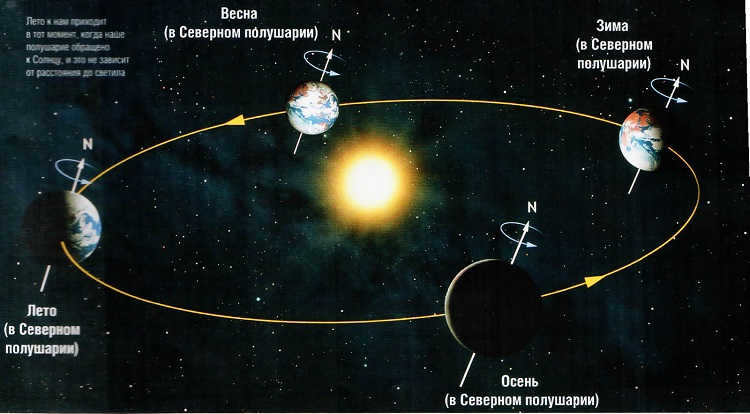
Aside from altering its position, the Earth’s axis also undergoes a slight lateral shift as a result of the planet’s movement. It can migrate in either direction at a rate of 10-15 centimeters per year. The melting of glaciers, reduced water levels, drought, and other factors also influence this phenomenon.
Rotation around its axis
You may be aware that our planet completes one full rotation around its axis in a period of 24 hours (to be more precise, 23 hours and 56 minutes). This phenomenon is responsible for the transition between day and night – depending on whether the western or eastern hemisphere is currently facing the Sun, it determines whether it is daytime or nighttime. The Earth moves in an eastward direction, which means that our star always appears to rise in the east and travels across the sky to the west throughout the day.
Due to the fact that our star emerges in the east, Japan, being the easternmost country in Eurasia, is often referred to as the “Land of the Rising Sun”.
Due to the Earth’s rotation, various moving streams like water and air are also deflected. Consequently, in the northern hemisphere, water in rivers flows to the right of latitudes parallel to the equator, while in the southern hemisphere, it flows to the left. This principle applies to all types of flows, from whirlpools to the drainage in your sink. You can test this yourself.
Here’s a fascinating experiment: fill up your bathtub or washbasin with water, close the drain, and then open it. You’ll notice that the resulting vortex spins in a clockwise direction, unless you happen to live in the southern hemisphere.
The Earth spins on its own axis at a speed of 465 meters per second, or 1,674 kilometers per hour. However, this measurement is only applicable at the equator. As you move towards the poles, the speed of rotation decreases. At the geographical poles, there is no linear speed of rotation. The angular speed, on the other hand, remains constant at 15 ° / h regardless of location on the globe.
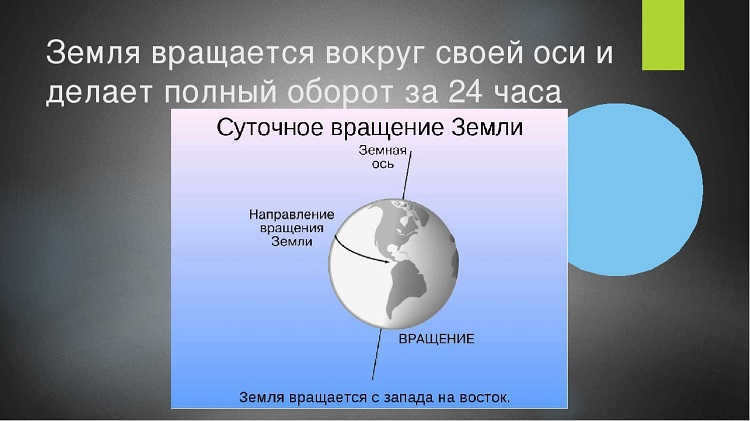
Orbiting the Sun
The Earth’s path around our star is not a perfect circle, but rather an ellipse, as the Earth’s orbit around the Sun is slightly elongated. The average distance from our planet to the Sun is approximately 149.6 million kilometers.
The Earth orbits around the Sun at a velocity of approximately 29.8 km/s. This speed is not constant and varies depending on its position in space. At its closest approach to the Sun (known as perihelion), the velocity exceeds 30 km/s, while at its farthest distance (aphelion), it drops to around 29 km/s.
The Earth completes a full revolution around our star in approximately 365 days (or rotations around its axis). This timeframe is referred to as one astronomical year.
The calendar year, in contrast to the astronomical year, is not constant. Because we consider a day as 24 hours instead of 23 hours and 56 minutes, every four years an extra day (February 29th) is added to the calendar. This type of year is known as a leap year.
Since there are no concepts of top and bottom in space, it is difficult to determine the direction in which our planet orbits the Sun. However, if we observe the solar system from above (from the side where the Earth’s north pole is located), the rotation is counterclockwise.
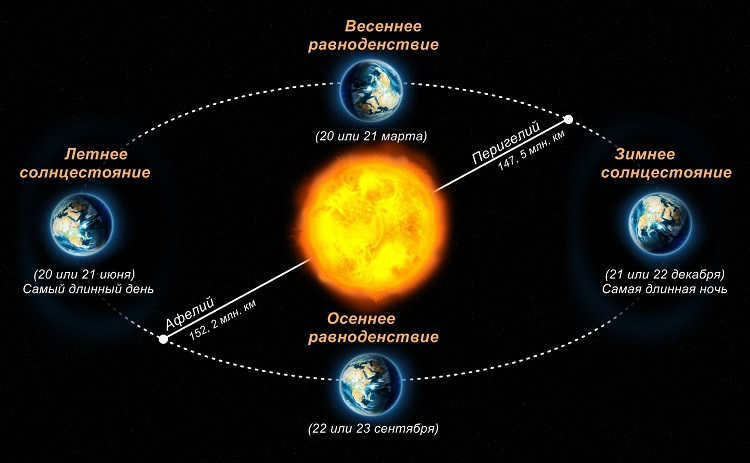
It is quite common for people to ponder why we do not perceive the Earth’s rotation around its axis or around the Sun. The explanation is rather straightforward: everything around us is in motion along with us. Let’s imagine being on a perfectly smooth airplane or train. While moving at a constant speed, neither accelerating nor decelerating significantly, all the objects surrounding us appear to be stationary. However, by looking out the window, we can observe a constantly changing environment. Unlike the objects inside the train or plane, the outside world is not moving along with us, allowing us to perceive our motion.
What if the Earth comes to a halt?
Imagine yourself driving a car at a speed of over 1500 km/h. What would occur if you abruptly hit the brakes? Correct, you would be propelled through the windshield at the same velocity due to inertia. Similarly, if the Earth were to suddenly stop rotating on its axis, the same fate would befall all living beings and objects on its surface. We would all be hurled into nearby mountain ranges, and the oceans would surge with such force that a massive portion of land would be swept away by an unprecedented tsunami.
However, even if the deceleration were gradual and everyone managed to survive, it would not last for long because:
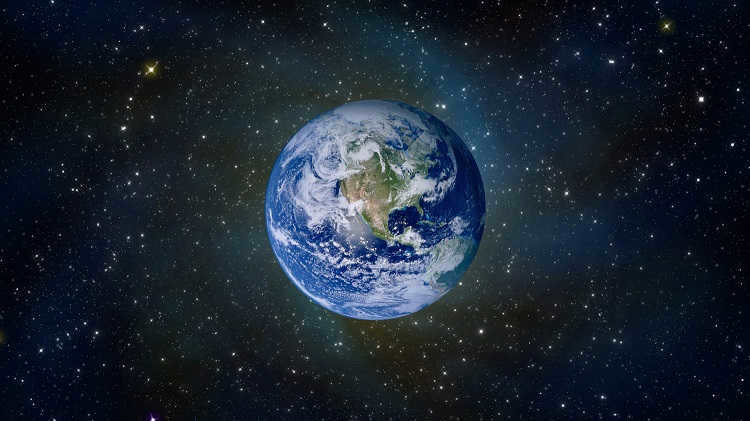

- One side of the planet would permanently face the Sun, resulting in extreme heat that would eventually evaporate its oceans.
- The other side would plunge into eternal darkness and freezing temperatures, causing its oceans to freeze over with a layer of ice several kilometers thick.
- Under such conditions, no terrestrial life forms (except for a few simple organisms) would be able to survive and thrive. Humans would certainly not be an exception.
If the Earth’s orbit around the Sun were to change in such a way that the day became a year long, with six months of daylight followed by six months of darkness, it would have significant consequences. One of the more noticeable changes would be that the sun would rise in the west instead of the east. However, this would be the least of our concerns.
Once the massive tsunami that engulfs everything in its path subsides, the water will begin to recede from the equator towards the poles. Currently, the Earth is not a perfect sphere and is slightly flattened at the poles due to centrifugal forces. However, once these forces stop, the water from the oceans will move towards the poles, causing flooding in the nearest landmass and leaving a single solid continent in the middle, most of which is currently the ocean floor.
The magnetic field of the Earth will also vanish, leaving the planet vulnerable to harmful space winds that will swiftly eradicate the remaining organisms that managed to survive the shutdown. Additionally, the disappearance of the Earth’s magnetic field will result in the disappearance of beautiful auroras, adding to the despair.
If the Earth ceases to orbit the Sun, the regular six-month cycle of day and night will cease to exist. One hemisphere will permanently transform into a dry desert, while the other will become a frozen wasteland, much like the conditions observed on Mercury due to its close proximity to the Sun and slow rotation.
The Sun is orbited by the Earth in an elliptical path, traveling at a velocity of approximately 30 km/s (106,000 km/h) [1]. Simultaneously, the Earth rotates on its axis at a speed of 465 m/s (1674 km/h) at the equator. However, the Earth’s orbital speed is not constant; it accelerates in July (after reaching aphelion) and decelerates in January (after reaching perihelion).
Earth’s Satellites
The Earth revolves around the Sun in a circular orbit. If the Earth followed an elliptical orbit, the Southern Hemisphere would never experience summer, while the Northern Hemisphere would be in winter, or vice versa.
Structure of the Earth
Internal Structure
The Earth’s crust constitutes the upper portion of the solid Earth, including the sedimentary cover. It is divided into various lithospheric plates of different sizes, which undergo relative movement. Plate tectonics describes the dynamics of these movements.
Earth’s Mantle: A Silicate Shell
The Earth’s mantle is a silicate shell that primarily consists of rocks made up of silicates of magnesium, iron, calcium, and other elements. When mantle rocks partially melt, they give rise to basaltic and similar melts that form the Earth’s crust as they ascend to the surface.
Comprising 67% of the Earth’s total mass and approximately 83% of its total volume, the mantle extends from depths of 5 to 70 kilometers below the Earth’s surface (where plate tectonics occur due to the pressure). Convection also takes place independently in the upper mantle. Some models propose an even more intricate convection structure.
The Core of the Earth
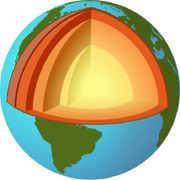
There is a hypothesis that the Earth’s core is composed of the hydrosphere [ ]
Main article: Water resources on Earth. The majority of the planet’s water is found in the oceans, with a smaller amount in rivers and groundwater. There are also significant water reserves in the atmosphere, such as glaciers, snow cover, and permafrost, which make up the Biosphere [ ]
The Biosphere refers to the parts of the Earth’s layers (lithosphere, atmosphere) that are inhabited by living organisms, influenced by them, and contains the byproducts of their life processes.
Atmosphere of the Earth
Main article: Earth’s atmosphere. The scientific fields of physics and chemistry that examine the Earth’s atmosphere are commonly known as atmospheric physics. The atmosphere plays a crucial role in meteorology, and changes in climate over time have a significant impact on geography.
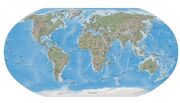
Boundaries on land There are about 251,480 kilometers of land borders.
Coastline The coastline stretches for 356,000 km.
The Earth consists of approximately 10^50 atoms in total.
Land Usage [ ]
Irrigated territory: 2,481,250 square kilometers (as of 1993)
Human Geography [ ]
It is estimated that only one-eighth of the Earth’s surface is suitable for human habitation, as three-quarters of the planet’s surface is covered by oceans and half of the land area is occupied by Canada. Antarctica is considered to be the southernmost point where humans live, and as of 2004, approximately 400 individuals have ventured beyond Earth, with 12 of them having walked on the moon. Refer to Administrative state [ ]
There are 267 administrative entities on our planet, which include states, dependent territories, and more. Unlike other planets, Earth does not have a central governing body. The entire land surface is divided into various regions, with the exception of certain areas under the jurisdiction of the United Nations. This organization serves as a platform for international discussions, acting as a forum with limited power. Throughout history, different empires have risen to power, starting with the Assyrian Empire (1353-609 BC), followed by Ancient Greece during the Hellenistic period (III-II centuries BC), and then the Roman Empire (754 B.C. to 476 A.D.). In more recent times, the United States and the USSR have been dominant world powers.
History of the Earth: A Unique Perspective
- ↑ The Earth’s average orbital velocity is approximately 29.765 km/sec. However, this speed varies from 30.27 km/sec (at perihelion) to 29.27 km/sec (at aphelion). This fascinating phenomenon has been extensively documented in the Big Soviet Encyclopedia.
Ever since the revolutionary heliocentric model was introduced, it has been widely accepted that the Earth orbits the Sun, not the other way around. Additionally, the Earth also rotates on its own axis. The scientific community, however, is still puzzled by the exact mechanisms behind these celestial processes. The intriguing question remains: what drives the movement of planets and other celestial bodies around the central star of our solar system? The Earth’s dual motion, as it revolves around the Sun while simultaneously spinning on its own axis, gives rise to the diurnal cycles and seasonal changes that are crucial for the sustenance of life on our planet.
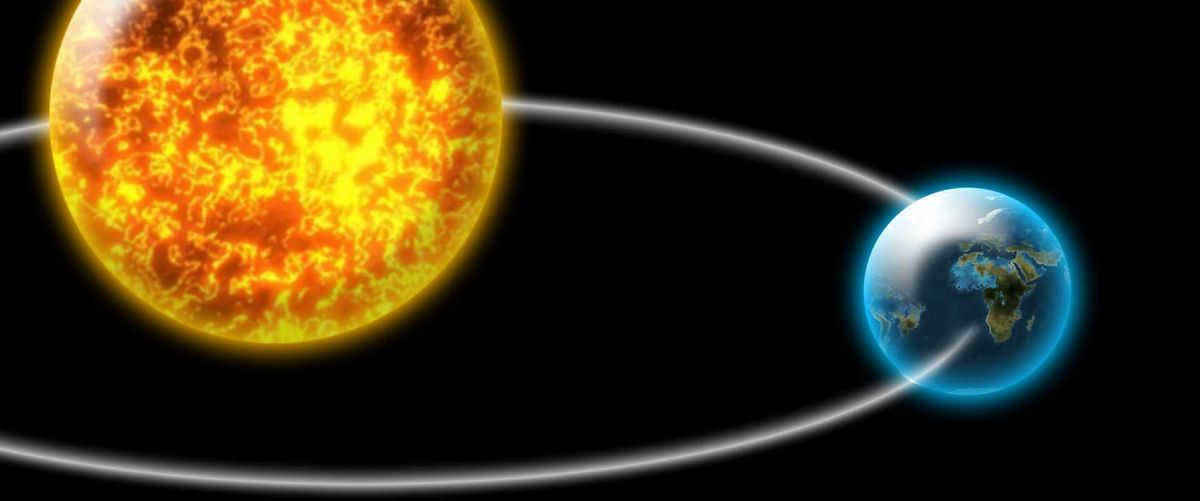
What causes the Earth to spin
There is no consensus on the reason behind the Earth’s rotation around the Sun. The prevailing theory suggests that it is a result of the processes that took place during the formation of the Earth. Protoplanets formed from cosmic clouds of gases and dust, and these protoplanets attracted other cosmic bodies. The collisions between these bodies likely set the Earth in motion.
This theory, however, fails to explain why our planet rotates specifically from west to east. Furthermore, the behavior of other planets in the solar system is even more puzzling: Venus rotates in a completely different direction, and Uranus is “tilted on its side”.
The Sun’s Orbit and the Rotation of the Earth
The Earth orbits around the Sun, traveling at a speed of approximately 30 kilometers per second in an elliptical path. The average distance from the Earth to the Sun is about 149.5 million kilometers (1 astronomical unit). This distance varies, with the Earth being closest to the Sun (perihelion) at approximately 147.1 million kilometers and farthest from the Sun (aphelion) at about 152.1 million kilometers.
As a result, the rotational velocity of the Earth is slightly higher at perihelion, exceeding 30 kilometers per second, and slightly lower at aphelion, decreasing to 29.3 kilometers per second.
The Earth completes one full revolution around the Sun in approximately 365 days, 5 hours, 48 minutes, and 46 seconds. To account for this slight discrepancy, an extra day is added to the calendar every four years.
There is a lot of interest in finding out what the Sun revolves around and whether it rotates on its axis. The Sun actually moves around the center of the galaxy. Additionally, it undergoes an axis rotation every 25 days at the equator and every 38 days at the poles.
The direction of the Earth’s orbit around the center of the galaxy
There is a great deal of curiosity about the direction in which the Earth rotates. The Earth’s rotation occurs in a counterclockwise direction as it orbits around the center of the galaxy. This direction can be observed by someone positioned “from above” near the North Pole of the Earth.
Reasons for the Alternation of Seasons
The alternation of seasons occurs as a result of the Earth’s annual rotation around the Sun and the tilt of its axis in relation to the plane of its orbit. The ellipticity of the orbit also has a slight impact on this process. The solstice and equinox points are used to determine the astronomical seasons.
If the Earth’s axis were not tilted, the length of day and night would remain constant at any given point on Earth. Throughout the year, the Sun would remain in the same position during the day, despite the Earth’s revolution around it.
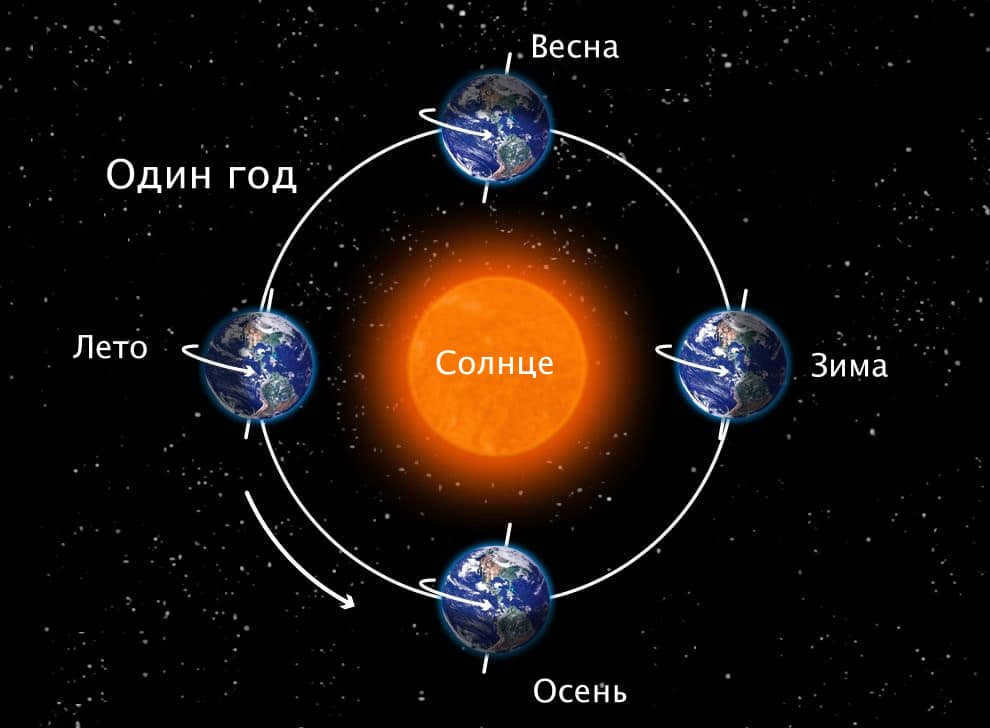
During the period between the equinoxes in September and March, the Sun is not facing the Northern Hemisphere for as long each day. As a result, the days become shorter and less heat reaches the Earth’s surface. Half a year later, the Earth is in the opposite position, causing the Southern Hemisphere to receive less heat. Thanks to the atmosphere’s inertia, the extreme temperature changes are smoothed out.
Because of the elliptical shape of the Earth’s orbit in the Northern Hemisphere, fall and winter are shorter compared to spring and summer. Conversely, in the Southern Hemisphere, spring and summer are shorter while winter and fall are longer.
Leap Year
A leap year is a year that adds an extra day to the solar calendar – February 29. In calendars that follow the luni-solar system, an additional month is added.
In our calendar, a leap year occurs every four years. However, there is an exception for years that are divisible by 100. These years are only considered leap years if they are also divisible by 400. For example, the year 2096 would be a leap year, but the year 2100 would not. The year 2000 was a leap year because it was divisible by 400.

The Jewish calendar includes a leap year by adding an extra month. Within a 19-year cycle, there are 7 leap years, resulting in a total of 235 lunar months with a duration of 29.5 days each. The average length of a year in the Jewish calendar is approximately 365 ¼ days, which corresponds to a complete orbit around the Sun.
In the Islamic calendar, each month consists of either 29 or 30 days. In the tabular calendar, a leap day is added to the last month every eleventh year of the 30-year cycle. This particular month is significant as it is when the Hajj pilgrimage takes place.
Is it possible for the Earth to plunge into the Sun?
It is impossible for our celestial abode to plunge into the Sun due to its continuous orbit around the star. The planet remains in a stable closed orbit thanks to the gravitational forces at play.
The Earth’s axial tilt
The Earth’s axis of rotation is tilted at an angle of 23.44° relative to the orbital plane, which is responsible for the cyclical change of seasons.
There are no factors that can alter the magnitude of the planet’s axial tilt. However, the gravitational pull of the Sun and the Moon’s revolution around the Earth cause a phenomenon known as precession, where the axis gradually changes its direction in space. This precession cycle takes approximately 24 thousand years to complete.
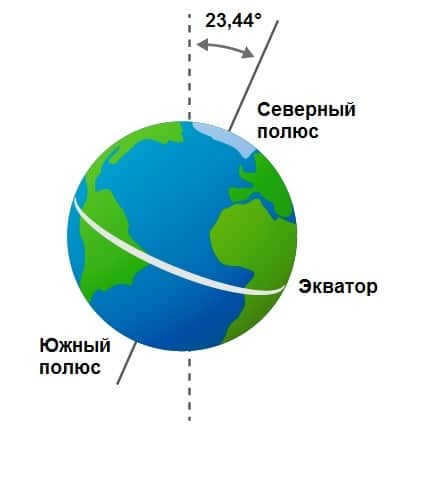
Currently, the northern pole is oriented towards the beginning of the Ursa Minor constellation. In approximately 12,000 years, it will shift its focus towards the star Vega. Another 12,000 years later, it will return to its original position.
The Axial Rotation of the Earth
The Earth completes a full rotation in a sidereal day, which lasts for 23 hours, 26 minutes, and 4 seconds. This duration is slightly shorter than the average solar day by 3 minutes and 56 seconds.
At the equator, the Earth’s axial rotation has a linear speed of over 465 m/s. However, as one moves towards the north, this speed gradually decreases and reaches 232.5 m/s at a latitude of 60°.
Interestingly, if an airplane were to fly at a speed of 837 km/h in the western direction at the latitude of St. Petersburg, it would effectively remain at the same location in the inertial reference frame.
At the poles, the linear rotational velocity is zero, while at any other point on the Earth, the angular velocity remains constant at 15°.
Using Foucault’s pendulum in the 19th century, it was possible to experimentally demonstrate the rotation of the Earth. Additionally, due to the Earth’s rotation and the resulting Coriolis force, objects launched horizontally are deflected to the right in the northern hemisphere.
Over the course of every century, the length of a day increases by approximately 0.001 seconds. Throughout history, the Earth has undergone changes in its rotational speed. Recently, researchers have uncovered cycles of acceleration and deceleration in the Earth’s rotation, occurring every 5 years.
Inertial rotation theory
This theory posits that in the past, the Earth underwent intense rotation, resulting in the acquisition of a “motion reserve” that now drives its inertia-based rotation. However, this theory fails to account for past fluctuations in rotational velocity.
Magnetic field theory
The magnetic field theory is based on the repulsion observed when two magnets with like poles are brought together. Similarly, the Earth’s poles, having the same charge, repel each other in different directions, thus explaining the planet’s rotation.
Another hypothesis proposes that the Earth’s magnetosphere exerts a force on the inner core, causing it to move in a westerly to easterly direction. This force ultimately drives the rotation of the planet.
Why is it impossible for humans to feel the Earth’s movement?
The reason why we are unable to sense the Earth’s rotation is because we are actually moving along with it at the same speed. From our perspective, everything around us appears to be still and motionless.
Distinguishing between True and Mean Solar Time
True local solar time is determined by the precise position of the Sun in relation to a specific location on Earth, as well as the Earth’s rotation on its axis. Due to the fact that our planet follows a non-circular orbit, the true time experienced can vary throughout the year. In certain instances, the difference between true time and mean solar time can be as much as 16 minutes.
The mean solar time is determined by the daily movement of the “average” imaginary Sun resulting from the Earth’s rotation. The time of the Sun’s highest point in the sky is calculated as 0 o’clock (midnight). To determine the mean solar time, the geographic longitude of a specific location must be converted into hours and minutes. For instance, Astrakhan’s longitude is 48°02′ E, which translates to 3:12 (since the Earth completes a full rotation of 360° in 24 hours). As a result, the mean solar time is offset from UTC by +3 hours and 12 minutes. Given that Astrakhan’s time is UTC+4:00, the mean solar noon occurs at 12:48 PM.
Date line
The date line is an imaginary line on the surface of the Earth that marks the change in date. In most cases, there is a 24-hour difference in local time on either side of the line. However, due to variations in time zones, this difference can range from 1 to 4 hours. The date line always runs along the sea, except for when it reaches Antarctica.
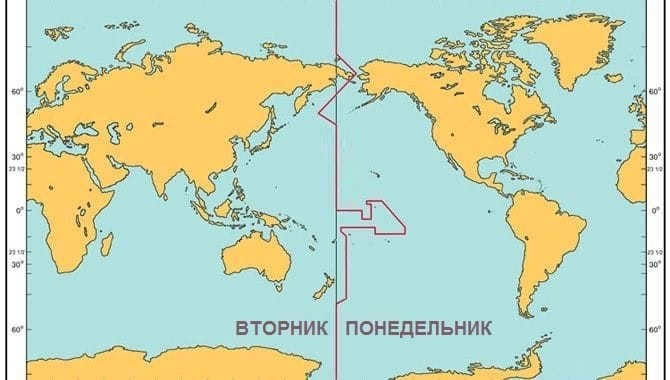
On the eastern side of this line, a new day has already begun, while on the western side, the previous day has already come to an end. It is fascinating to note that the Line Islands are 14 hours ahead of Greenwich Mean Time, making them the first to welcome each new day. The time in the Line Islands is one day ahead of Hawaiian time, which is 10 hours behind Greenwich Mean Time.
What if the Earth suddenly stopped spinning?
If the Earth were to suddenly come to a halt on its axis, several significant changes would occur:
- One side of the Earth would be permanently facing the Sun, resulting in extreme temperatures and the evaporation of all moisture.
- On the opposite side, there would be no sunlight, leading to freezing temperatures and the accumulation of kilometers of ice.
- These conditions would make it extremely difficult for life to survive.
- A single day would last an entire year.
Due to the planet’s immense rotational speed, any objects and structures will be completely wiped out and annihilated by the overwhelming force of inertia once the planet abruptly halts its rotation. The powerful impact of this force will also result in catastrophic tsunamis unleashed by the oceans. As a consequence, water will surge towards the poles, resulting in the emergence of vast stretches of land near the equator. Furthermore, the absence of a magnetic field will expose all forms of life to the deadly effects of radiation and ultraviolet rays, leading to their ultimate demise.





